- Advisory services
- Consultations
- Network and technology policies
- Network and technology service docs
- Using Jisc community
- Network and technology service docs
- Domain name registration
- How to sign up
- Janet Support Manual
- Janet CSIRT
- Back-up services
- eduroam
- Backup Web Hosting
- Certificate Service
- Connection timeline
- Eligibility
- Janet 3G Buyer's Guide
- Janet 3G eduroam interoperablity authentication methods
- Janet Mail Services
- Janet Network Charges
- Janet Reach
- Janet Videoconferencing Feedback results
- Primary connections
- Supporting Business Continuity
- Business and Community Engagement (BCE) using Janet
- Cost
- Interconnect connections
- Connecting student accommodation
- Customer-owned routing equipment
- Obtaining a Janet IP Address Range
- Terms for the Provision of the Janet Service
- Upgrading your existing bandwidth and Janet router
- Fault reporting
- IP address assignment
- Janet Aurora
- Janet Netsight
- Janet txt
- Routers
- Network set-up
- Guest access
- Network time service
- Training
- Contact
- Primary Nameserver Service
- Secondary Nameserver Service
- Vscene
- Vscene
- Vscene updates and revisions
- Login Options
- Jisc and Ajenta partnership FAQ
- Learn more about Vscene
- Vscene Help and user guides
- Videoconferencing service policies
- ISDN
- Content providers
- Technical documentation
- Technical details
- Learn more about Vscene
- Introduction to Videoconferencing
- User registration
- Vscene virtual rooms
- Support
- Organisation - registration and management
- Search
- Video systems
- Videoconferences - scheduling and making changes
- Connection information
- Joining via a browser (Version 2, March 2017)
- Joining via a browser
- Recording your videoconferences
- Visimeet
Videoconferences - scheduling and making changes
- My videoconferences
- Viewing the conference details
- How to start or schedule a conference
- Modifying a videoconference
- Modifying a hardware system reservation
- Saving your videoconference as a draft
- Modifying a draft videoconference
- Modification history
- Setting your videoconference to recur as part of an ongoing series
- Recurring videoconferences
- Adding a guest video system to a scheduled conference
- Resolving a scheduling conflict
- Recording your videoconference
- How individual participants can change their chosen video system
My videoconferences
The My Videoconferences page, allows you to see all of the videoconferences you have scheduled, are participating in, or can administer.
If you are an administrator for a VC system or an organisation, all conferences for have been booked using the VC system or across the organisation will also be shown.
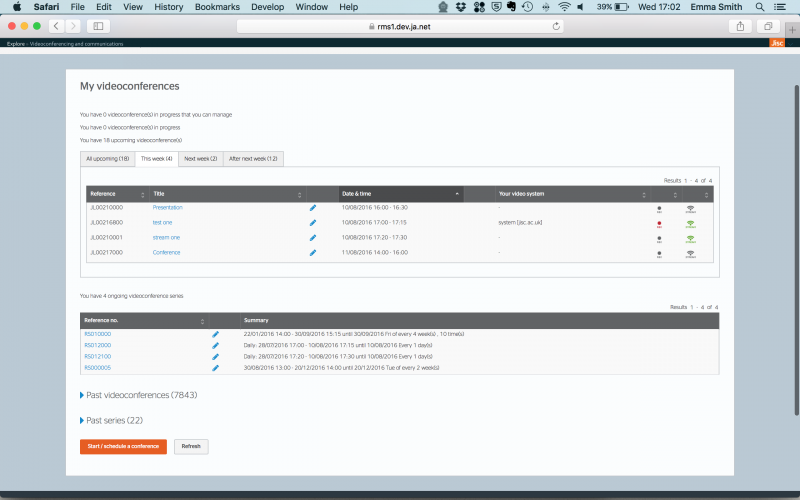
All videoconferences show are divided into separate tables for:
a) videoconferences currently in progress
b) videoconferences that are coming up (users can see all upcoming conferences, or conferences this week only/next only, or beyond)
c) Ongoing videoconferences (i.e. a regular series of meetings, which have been booked to occur on a weekly basis/monthly basis etc)
Users can click on the conference title (or reference number in the ongoing videoconferences table) to view details of the videoconference. Should a user wish to make changes to the conference, a user can click on the pencil icon.
A user is also able to manage conferences they have booked. All conferences a user can manage will be indicated by a visible orange, ‘Manage’ button.
Users can also view all past videoconferences and past videoconference series, by clicking on the drop down tabs at the bottom of the page.

Viewing the conference details

A user can view details of an individual videoconference by either clicking on the conference title or reference ID. Details shown on the Conference Details page are as follows:
a) Reference ID (this ID is unique and is useful to identify your videoconference should a user need to contact the Vscene Service Desk)
b) MCU (this is the Multipoint Control Unit, the videoconference has been allocated)
c) Date & time of videoconference
d) Status (this indicates your videoconference has been scheduled on Vscene)
e) Record & stream (these icons will be highlighted if the videoconference will be recorded or streamed)
f) Attendee list (this table shows all of the meeting attendees, their video systems, and any network information, including the E.164 number Vscene will dial or if the attendee will join via a browser)
g) Manager list (this table shows the videoconference manager(s) and their email addresses, should the user or attendees need to contact them)
h) Modification history (this table details any changes or modifications that have been made to the videoconference)
i) Layout (this shows the layout of the videoconference, as seen be all attendees)
All of the conference details can be changed in advanced (by clicking on the ‘edit’ button) or during the conference if a user is the conference manager.
Users have a chance to delete the conference if no longer needed, or repeat the conference at a later date by clicking on the respective buttons.
How to start or schedule a conference

Users have the option to either schedule a videoconference in advanced or simply create a conference that starts immediately or in 10 minutes time.
Each conference is automatically given a unique conference title, which can be changed by the booker to make it more meaningful to the user and any attendees.
To schedule a conference, a user can set the time and date, and, if it is an ongoing videoconference series, a user can choose to set the recurrence.
Users can also choose to reserve a videoconference system, so that the system or its location can be used for another purpose.

To add attendees to the conference, users can type the attendees name or email address. This will search all registered users on Vscene and add them to the videoconference. If an attendee is registered, the video system box will be automatically populated with their favourite video system. Please note, that it is worthwhile checking with all attendees that these will indeed be the video systems they will be using on the day. Any video system that is not available for use during the conference will have a red cross icon next to the video systems box.
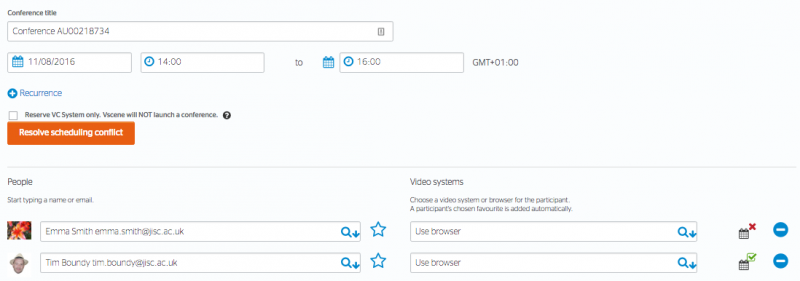
Attendees not registered on Vscene can be also be added to a booking by entering their email address into the attendee list.

In addition to the details above, there are some additional options for users:
a) Layout and lecture mode – If there are more than two participants in a videoconference, it is recommended that a suitable layout is chosen. Lecture mode allows one participant to be selected as the lecturer. This means that all other participants view the lecturer only, but the lecturer can see all participants on their screen.
b) Managers – Additional conference managers can been added. Managers can manage the conference as it happens.

c) Streaming – Users can choose to streaming the videoconference via this tab. Users can also choose to password protect the stream.

d) Recording – Users can choose to record the videoconference, as well as choosing the type (video and/or audio) and resolution etc. Users will be emailed a download link after the videoconference.

e) Call-in/call-out – Vscene, when added to a videoconference usually automatically calls registered video systems. However, sometimes there is a preference for participants to dial into to Vscene, which can be selected via this tab. Participants will be emailed a number to dial to join the videoconference.
f) Additional Info – Users can add any important information that should be noted by either participants or the Vscene Service Desk.
Once all the necessary details have been added, a user can choose to either schedule the conference or start the conference now. Users can also choose to delay the start by 10 minutes, to allow participants to go to their videoconferencing locations.
Modifying a videoconference
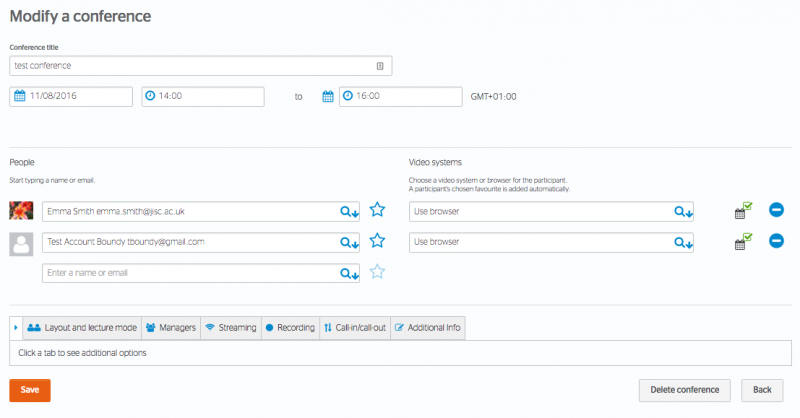
Users can modify a scheduled conference at any time, by clicking on the ‘edit’ button. Please note, that if the conference details are changed within 5 minutes of the start time, a user should see a confirmation page and receive a confirmation email to confirm these changes. Users can also check the status of the conference on the conference details page. If changes have been accepted, the status will say ‘scheduled’. If in doubt, please contact the Vscene Service Desk.
Modifying a hardware system reservation

Users can modify a reservation at any time, by clicking on the ‘edit’ button. Please note, that if the conference details are changed within 5 minutes of the start time, a user should see a confirmation page and receive a confirmation email to confirm these changes. Users can also check the status of the conference on the conference details page. If changes have been accepted, the status will say ‘scheduled’. If in doubt, please contact the Vscene Service Desk.
Saving your videoconference as a draft
Draft videoconferences can be used to save the details of a scheduled conference before committing or launching it.
Any user can create a draft conference by choosing to Save As Draft during the scheduling process. Draft conference can be returned to later to finish and schedule.
Creating a draft conference is useful if:
- You know most of the details of a conference but would like to confirm something before scheduling.
- You are expecting to make lots of changes to a conference before you commit it.
- You want to use a Draft conference as a template for a similar conference that happens frequently.
Modifying a draft videoconference
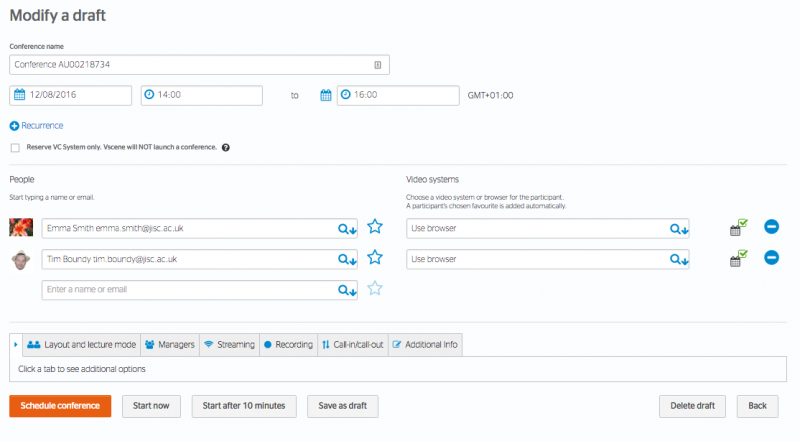
Users can modify a draft booking at any time, by clicking on the ‘edit’ button. Users can choose to save the draft or commit the videoconference by clicking on the ‘Schedule conference’ or start buttons. Please note, that if the conference details are changed within 5 minutes of the start time, a user should see a confirmation page and receive a confirmation email to confirm these changes. Users can also check the status of the conference on the conference details page. If changes have been accepted, the status will say ‘scheduled’. If in doubt, please contact the Vscene Service Desk.
Modification history
The Modification History table details any changes or modifications that have been made to the videoconference, by either the videoconference booker or Vscene Service Desk.
Setting your videoconference to recur as part of an ongoing series

Users can choose to repeat the videoconference and create an ongoing series. Users can choose the frequency of the series (every day/week/month/third Friday of every two months etc) as well as choose a start and end date or number of occurrences for the whole series.
Recurring videoconferences
By clicking on the reference number of an ongoing videoconference series, users can view all the recurring videoconferences that have been booked as part of the series. Details include the series start date and end date and regularity of the series. Users can view further details of each individual videoconference by clicking on the videoconference title.

Adding a guest video system to a scheduled conference
A Guest Video System refers to a video system that is not registered on Vscene.
Guest Video Systems can be used by both guest participants and registered Vscene users.
A guest participant is someone who does not have a Vscene account. When adding a guest, you will need to provide an email address so Vscene can inform the guest about the conference.
There are several options for Guest Video systems. You will need to consider the equipment or software that they have access to and if they will want to dial-in to the conference or if Vscene should call them. Whatever you choose, every participant is provided with a link to enable them to change the way they participate before the conference if necessary.
Resolving a scheduling conflict

Should one or more video systems be unavailable, Vscene will allow users the chance to resolve the scheduling conflict.
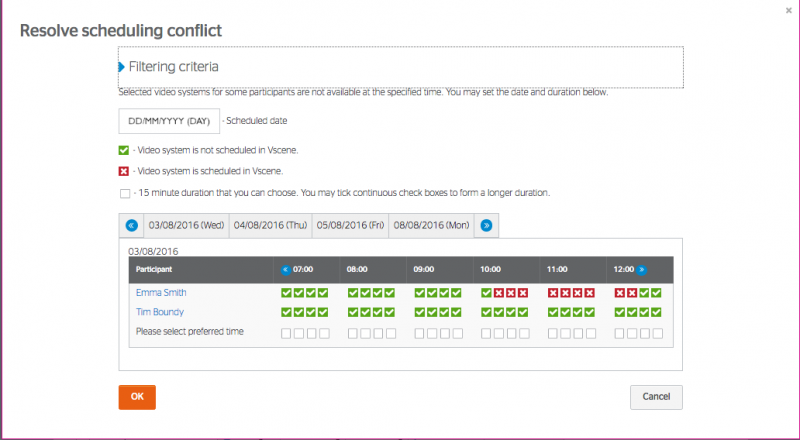
By clicking on the ‘Resolve scheduling conflict’ button, Vscene will indicate when the video systems are next available.
Recording your videoconference
You must be granted permission to record conferences by your local Organisation Administrator before the facility becomes available. Permission can be requested via the schedule a conference page by attempting to add recording.
You can select to record a conference during scheduling, editing a conference or whilst the conference is running.
Recordings are made available to download for 14 days, after which point they are deleted. The Recordings pages shows how many days remain until deletion. Recordings are provided in MPEG4 (.mpg) format in the quality originally requested. The size of the file is dependent on the quality and the length of recording.
Only the Owner (the original scheduler) of the conference can access and download the recording.
The Owner of the conference must ensure that they have permission to record from all participants before the recording starts.
How individual participants can change their chosen video system
All participants receive a confirmation email, which includes details of the scheduled conference. Participants can click on a URL in this email to choose a different video system for joining the conference. Participants can also choose to decline the meeting via this link.






